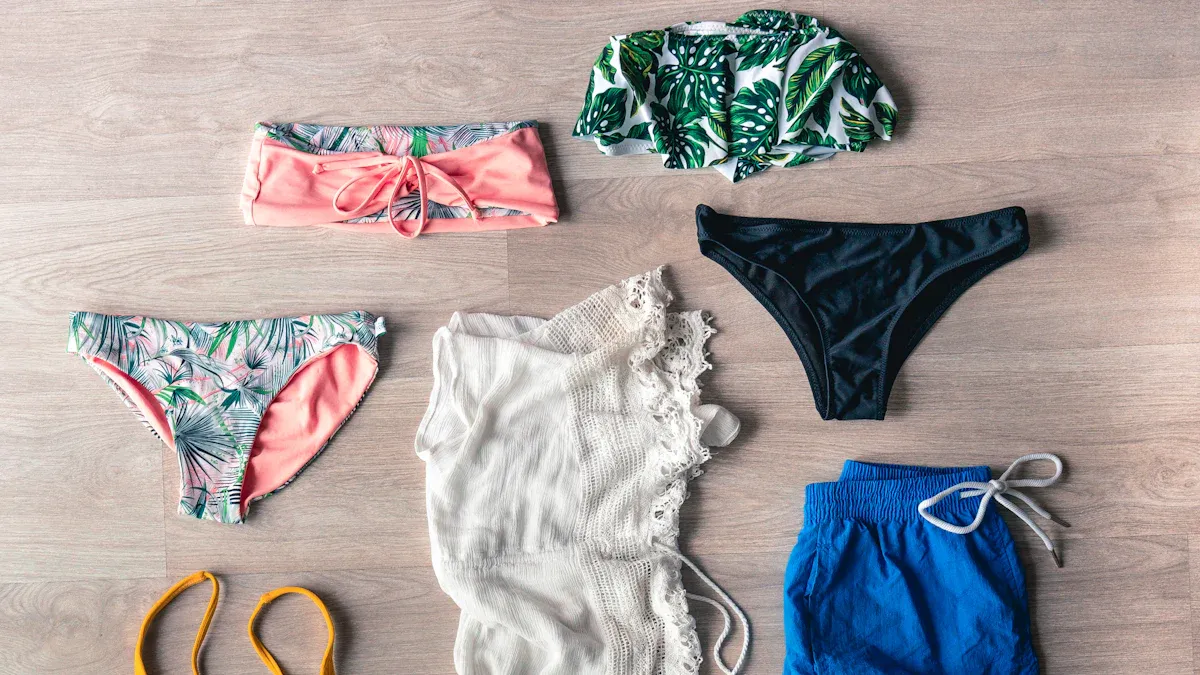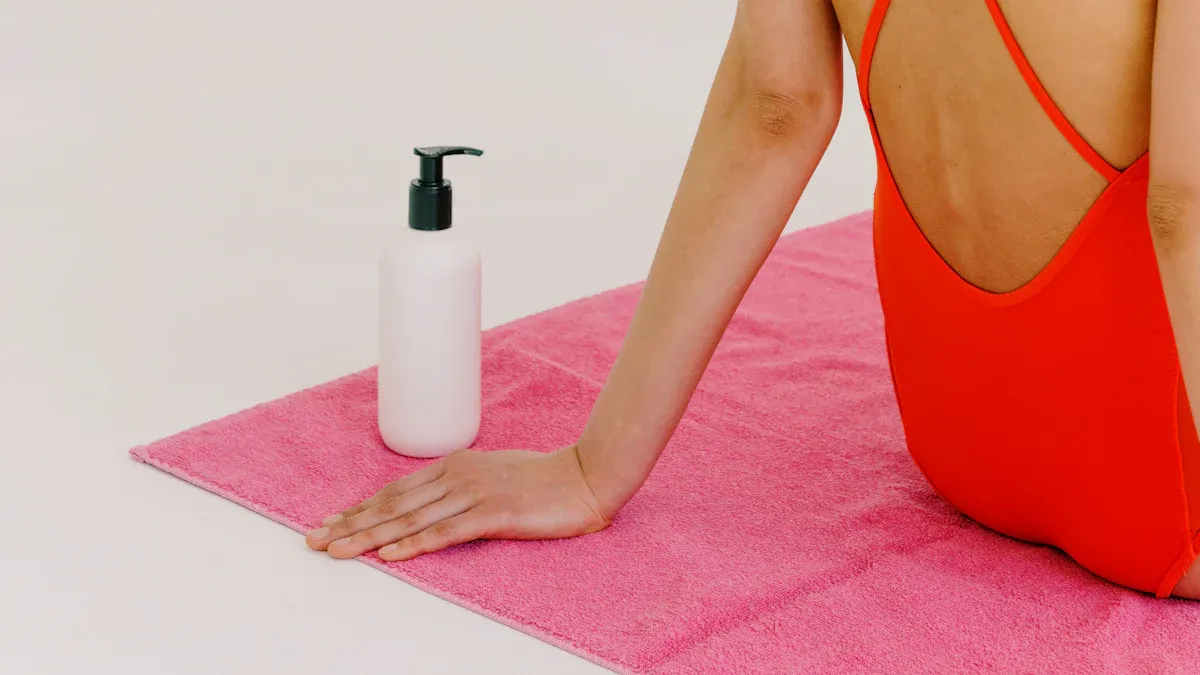
When it comes to swimwear, the fabric you choose can make or break your experience. The right swimwear fabric keeps you comfortable, moves with your body, and lasts longer. Whether you're splashing in the pool or chasing waves at the beach, the material plays a huge role in how your swimwear performs. Some fabrics stretch better, while others resist chlorine or protect your skin from the sun. Picking the right one ensures you enjoy every moment in the water.
Key Takeaways
Pick swimwear fabric based on what you’ll do. Nylon works for casual swims, and polyester is best for pools because it resists chlorine.
Choose 4-way stretch fabrics for comfort and easy movement. These fabrics let your swimwear move with you.
Think about eco-friendly fabrics like ECONYL® and Repreve®. These recycled materials work well and help the planet.
Rinse your swimwear after swimming to wash off chlorine and salt. This keeps the fabric strong and lasting longer.
Look for swimwear with UV protection. Fabrics with UPF ratings keep your skin safe from the sun.
Common Swimwear Fabrics and Their Pros and Cons

Nylon
Lightweight and quick-drying properties
Nylon is a popular choice for swimwear fabric because it feels light and dries quickly. You’ll love how it hugs your body, offering a snug and comfortable fit. Its breathability also makes it great for staying cool on hot days.
However, nylon isn’t perfect. It doesn’t hold up well in chlorinated water. Over time, exposure to pool chemicals can weaken the fabric, causing it to wear out faster.
Susceptibility to chlorine damage
Here’s a quick comparison of nylon and polyester to help you understand their differences:
Feature | Nylon | Polyester |
|---|---|---|
Durability | Less resistant to chlorine, wears out faster with pool chemicals | More resistant to chlorine, lasts longer in chlorinated pools |
Breathability | More breathable, dries faster | Less breathable, retains more water, longer drying times |
Comfort | Softer, more flexible, snug fit | Stiffer, less malleable |
Polyester
High chlorine resistance and durability
If you’re swimming in pools often, polyester is a smart choice. It resists chlorine better than nylon, so it lasts longer. This makes it a durable option for frequent swimmers.
Limited stretch compared to spandex
On the downside, polyester doesn’t stretch as much as other fabrics like spandex. It can feel a bit stiff, which might not be as comfortable for activities requiring a lot of movement.
Tip: Polyester swimwear is ideal for competitive swimmers who need durability over flexibility.
Spandex (Lycra/Elastane)
Excellent stretch and fit for comfort
Spandex is the go-to fabric for flexibility. It stretches beautifully, giving you a perfect fit that moves with your body. Whether you’re diving into the pool or playing beach volleyball, spandex keeps you comfortable.
Reduced durability in chlorinated water
But spandex has its limits. Chlorine can break down its fibers over time, reducing its lifespan. If you’re using spandex swimwear in pools, rinse it thoroughly after each use to keep it in good shape.
Note: Both nylon and polyester, like spandex, have environmental impacts. Their production relies on petrochemicals, which consume resources and pollute the environment. Plus, these fabrics are non-biodegradable, contributing to long-term waste.
Recycled and Sustainable Fabrics
When it comes to eco-friendly swimwear, recycled fabrics like ECONYL® and Repreve® are making waves. These materials are not only better for the planet but also perform just as well as traditional options. If you're looking to reduce your environmental footprint without sacrificing quality, these fabrics are worth considering.
Eco-friendly options like ECONYL® and Repreve®
Recycled fabrics like ECONYL® are made from waste materials such as discarded fishing nets and old carpets. This process helps reduce non-biodegradable waste while creating high-quality swimwear fabric. Repreve®, on the other hand, is crafted from recycled plastic bottles, giving new life to materials that would otherwise end up in landfills.
Here’s a quick look at the advantages of ECONYL®:
Advantage | Description |
|---|---|
Sustainability | Made from recycled nylon waste, reducing non-biodegradable waste. |
Durability | Retains the quality and properties of nylon, suitable for swimwear. |
Performance | Resistant to chlorine, UV rays, and other environmental factors. |
These fabrics don’t just help the environment—they also deliver on performance. They resist chlorine and UV rays, making them perfect for long-lasting swimwear.
Balancing sustainability with performance and durability
You might wonder if recycled fabrics can match the performance of traditional materials. The good news? They absolutely can.
Recycled swimwear fabrics offer comparable stretch and drying speed.
They provide the same level of UV protection as conventional options.
By choosing sustainable swimwear fabric, you’re not only helping the planet but also getting a product that performs just as well. Plus, using recycled materials reduces the need for new synthetic production, which consumes energy and petroleum. It’s a win-win for you and the environment.
So, the next time you shop for swimwear, consider eco-friendly options. They’re stylish, durable, and kind to the planet.
Key Factors to Consider When Choosing Swimwear Fabric
Stretch and Fit
Importance of 4-way stretch for comfort and movement
When you're swimming, your body moves in all directions. That's why 4-way stretch fabrics are a game-changer. These materials stretch both lengthwise and crosswise, giving you maximum flexibility. Whether you're diving, flipping, or just lounging, this stretch ensures your swimwear moves with you. Plus, it snaps back into shape after every use, so you never feel restricted. Many athletic swimwear brands use this type of fabric because it enhances performance and comfort.
Fabrics that retain shape and elasticity over time
Not all fabrics hold up after repeated use. If you want swimwear that stays snug and doesn't sag, look for these options:
Polyester: It resists fading, repels water, and keeps its shape even after multiple swims.
PBT (polybutylene terephthalate): A favorite among professional swimmers, it offers excellent chlorine resistance and long-lasting elasticity.
Durability
How to identify long-lasting swimwear fabrics
Durability matters, especially if you're a frequent swimmer. To spot fabrics that last, check for these features:
Resistance to chlorine, saltwater, and UV rays.
Elasticity that bounces back after stretching.
A smooth texture that doesn't wear down easily.
Some of the most durable options include:
Polyester: Known for its toughness and resistance to chemicals.
Nylon: Lightweight and abrasion-resistant, though less chlorine-resistant than polyester.
Recycled fabrics: Options like Econyl and Repreve are not only eco-friendly but also built to last.
Materials that resist wear and tear from frequent use
Polyester and nylon blends are your best bet for swimwear that can handle regular use. They dry quickly, resist fading, and maintain their shape. Recycled polyester is another excellent choice, offering durability while being kind to the planet.
Chlorine Resistance
Why chlorine damages swimwear fabric
Chlorine is tough on swimwear. It reacts with water to form acids that break down fibers over time. This process, called oxidation, weakens the material, making it brittle and less elastic. Fabrics like nylon and spandex are particularly vulnerable, so they need extra care.
Best fabrics for frequent pool use
If you're always in the pool, choose swimwear made from polyester blends. Polyester resists chlorine better than most fabrics, making it ideal for frequent exposure. A blend with at least 85% polyester and 15% spandex offers the perfect mix of durability and flexibility. This combination ensures your swimwear lasts longer while staying comfortable.
UV Resistance
Protecting your skin with UV-blocking fabrics
When you're out in the sun, your swimwear does more than just keep you stylish. It can also protect your skin from harmful UV rays. Fabrics with a UPF (Ultraviolet Protection Factor) rating are specially designed to block these rays. Manufacturers achieve this by using tightly woven materials or adding UV-absorbing particles to the fabric. A UPF 50+ rating, for example, allows only 1/50th of UV radiation to pass through, offering excellent protection.
This level of protection is especially important for outdoor swimmers. Water reflects sunlight, increasing your exposure to UV rays. Wearing UV-blocking swimwear reduces the risk of sunburn and long-term skin damage. It also helps prevent premature aging caused by photoaging and lowers your chances of developing skin cancer. Plus, it gives you peace of mind, so you don't have to reapply sunscreen as often.
Tip: Look for swimwear with a UPF label to ensure you're getting the best sun protection.
How to check for UV protection in swimwear
You can't tell if a fabric blocks UV rays just by looking at it. Instead, check for certifications or labels that indicate tested protection levels. Here are some reliable standards to look for:
Hohenstein Quality Labels: These labels show that the fabric has been tested for sun protection, with ratings ranging from UPF 15 to 50+.
UV STANDARD 801 Certification: This certification ensures the fabric meets strict international standards for UV protection.
By choosing certified swimwear, you can enjoy your time in the sun without worrying about harmful rays.
Sustainability
Benefits of choosing eco-friendly swimwear fabric
Switching to sustainable swimwear fabrics benefits both you and the planet. Traditional materials like polyester and nylon take hundreds of years to decompose, contributing to landfill waste. In contrast, recycled fabrics reduce this waste by repurposing materials like plastic bottles and fishing nets.
For example, recycled PET (polyethylene terephthalate) supports a circular economy by turning old plastics into new swimwear. Other options, like Amni Soul Eco® Thread, biodegrade in landfills within three years, cutting down on pollution. Natural materials like cotton, hemp, and bamboo also break down naturally, making them excellent eco-friendly choices.
Material | Benefit |
|---|---|
Recycled PET | Turns old plastic bottles into swimwear, reducing landfill waste. |
Amni Soul Eco® Thread | Biodegrades in three years, minimizing long-term pollution. |
Natural Rubber | Offers elasticity and biodegradability, unlike synthetic neoprene. |
Cotton, Hemp, Bamboo | Break down naturally and can be grown organically to reduce water and chemical use. |
Choosing sustainable swimwear fabric helps protect the environment while still delivering great performance.
Popular sustainable materials and their performance
One standout material is ECONYL®, a sustainable nylon made from waste like fishing nets and fabric scraps. It matches the quality of traditional nylon and can even be recycled infinitely. Here's how ECONYL® works:
Rescue: Collect waste materials from oceans and landfills.
Regenerate: Purify the materials to restore them to high-quality nylon.
Remake: Process the regenerated nylon into swimwear yarn.
Reimagine: Use the yarn to create new swimwear, which can be recycled again.
By choosing materials like ECONYL®, you're not just getting high-quality swimwear—you're also supporting a more sustainable future.
Matching Swimwear Fabrics to Your Needs

Recreational Swimming
Comfortable and stylish fabrics for casual use
When you're swimming for fun, comfort and style are key. You want fabrics that feel soft against your skin and look great. Nylon is a fantastic choice because it's lightweight and offers a snug fit. Spandex blends are another option, giving you that extra stretch for all-day comfort. Polyester, while slightly less soft, stands out for its durability and vibrant colors.
Here’s a quick comparison to help you decide:
Fabric Type | Comfort | Style | Durability | UV Protection |
|---|---|---|---|---|
Nylon | Soft, lightweight | High | Moderate | UPF 5 (up to 50+ with treatments) |
Polyester | Quick-drying, durable | Moderate | High | UPF 15 (up to 50+ with treatments) |
Spandex | Stretchy, flexible | High | Moderate | Varies with blend |
PBT | Chlorine resistant | Moderate | High | Varies with blend |
Quick-drying options for convenience
Nobody likes soggy swimwear. For quick-drying fabrics, look for high polyester or nylon content. These materials repel water and dry fast, making them perfect for casual swimming. Nylon-spandex blends are especially great because they combine softness with quick-drying properties.
Tip: Fabrics like microfiber and mesh improve airflow, helping your swimwear dry even faster.
Competitive Swimming
High-performance fabrics for speed and durability
Competitive swimmers need swimwear that enhances performance. Polyester blends with spandex are ideal because they provide muscle compression without restricting movement. PBT is another excellent choice. It reduces water drag and maintains its shape even after countless laps.
Key Features of High-Performance Fabrics:
Chlorine resistance for long-lasting durability.
Muscle compression to improve speed and reduce fatigue.
UV protection to maintain color and fabric quality.
Importance of chlorine resistance for frequent training
Chlorine can wreak havoc on swimwear. It causes fading, stretching, and loss of elasticity. Fabrics like polyester and PBT resist chlorine damage, ensuring your swimwear lasts through rigorous training sessions.
Note: A blend of 85% polyester and 15% spandex offers the perfect balance of durability and flexibility.
Family Activities and Water Sports
Durable fabrics for active movement and play
For family outings or water sports, durability is a must. Polyester and PBT fabrics shine here. They resist wear and tear, making them perfect for activities like paddleboarding or beach volleyball. Nylon is also a strong contender, offering comfort and ease of movement.
Quick-drying and damage-resistant materials
Water sports demand fabrics that dry quickly and withstand rough conditions. Polyester dries fast and retains its shape, while PBT offers excellent chemical resistance. Nylon-spandex blends are another great option, combining stretch with abrasion resistance.
Fabric Type | Pros | Cons |
|---|---|---|
Polyester | Soft, durable, colorfast, UV resistant, quick dry, retains shape | Not eco-friendly, quality may vary |
PBT | Resistant to chemicals, comfortable, moisture resistant, quick dry | Petroleum-based, not eco-friendly, less stretchy |
Nylon | Strong durability, easy to wash, soft, comfortable | No UV resistance, can be damaged by chlorine |
By choosing the right swimwear fabric, you can enjoy every splash, dive, and wave with confidence.
Tips for Maintaining Swimwear Fabric
Taking care of your swimwear fabric is just as important as choosing the right one. With proper maintenance, you can keep your swimsuit looking fresh and lasting longer. Here’s how you can do it:
Rinsing After Use
Removing chlorine and salt to prevent damage
After a swim, your suit collects chlorine, salt, sand, and even sunscreen residue. These substances can harm the fabric, causing discoloration and weakening its fibers. Rinsing your swimwear right after use helps wash away these harmful elements, keeping the material intact and vibrant.
Rinsing removes chlorine and salt, which can degrade the fabric.
It prevents discoloration and keeps your swimsuit looking new.
Regular rinsing maintains the elasticity and overall quality of the material.
Best practices for rinsing swimwear fabric
To rinse your swimwear effectively, use cool tap water. Avoid hot water, as it can damage the fibers. Gently squeeze out the water without twisting or wringing the fabric. This simple step can make a big difference in extending the life of your swimsuit.
Washing and Drying
Gentle washing techniques to preserve fabric quality
Washing your swimwear the right way is key to keeping it in top shape. Follow these tips for a gentle clean:
Pre-rinse your swimsuit in cool water to remove chemicals and debris.
Turn it inside out before washing to protect the outer layer.
Wash in cold water to prevent shrinking or fading.
Skip fabric softeners and bleach, as they can harm the material.
After washing, roll your swimsuit in a clean towel to remove excess water. Lay it flat in the shade to dry. Avoid hanging it by the straps, as this can stretch the fabric. Never use a dryer, as the heat can cause irreversible damage.
Avoiding heat damage during drying
Heat is your swimsuit’s worst enemy. Direct sunlight and dryers can weaken the fibers, causing fading and loss of elasticity. Always air-dry your swimwear in a shaded area to keep it looking and feeling great.
Tip: Lay your swimsuit flat on a towel to dry. This prevents stretching and helps it retain its shape.
Storage
Proper storage to prevent stretching or fading
Storing your swimwear correctly ensures it stays in good condition between uses. Always make sure your swimsuit is completely dry before putting it away. This prevents mold and mildew, which can degrade the fabric.
Store your swimwear flat in a cool, dry place to avoid creases and elastic strain.
Keep it away from rough surfaces to prevent snags and tears.
Separate light and dark swimsuits to avoid color transfer.
Tips for keeping swimwear fabric in good condition
Proper storage protects your swimsuit from environmental factors like extreme temperatures, UV rays, and humidity. By taking a few extra steps, you can maintain the integrity of the fabric and enjoy your swimwear for many seasons.
Note: Avoid folding your swimsuit tightly or stuffing it into small spaces. This can stretch the fabric and cause it to lose its shape.
With these simple care tips, your swimwear will stay comfortable, stylish, and ready for your next adventure!
Choosing the right swimwear fabric can make all the difference in your swimming experience. It keeps you comfortable, enhances performance, and ensures your swimsuit lasts longer. To get the most out of your swimwear, consider factors like durability, stretch, UV resistance, and sustainability. Proper care is just as important. Rinse your swimsuit after every use, hand wash with gentle detergents, and air dry in the shade. These simple steps prevent damage from chlorine, salt, and sunscreen, helping your swimsuit stay in great shape for years.
FAQ
How do I know if a swimwear fabric is chlorine-resistant?
Check the label or product description. Look for fabrics like polyester or PBT, which resist chlorine damage. If it mentions "chlorine-resistant" or "ideal for pool use," you're good to go.
Tip: Avoid swimwear with high spandex content for frequent pool use.
Can I wear recycled swimwear in saltwater?
Absolutely! Recycled fabrics like ECONYL® and Repreve® perform well in saltwater. They resist damage from salt and UV rays, making them perfect for beach days.
Sustainable swimwear is a win for you and the planet!
What’s the best fabric for competitive swimming?
Polyester blends or PBT fabrics work best. They offer durability, chlorine resistance, and compression for better performance. These fabrics also maintain their shape after repeated use.
How can I prevent my swimwear from fading?
Rinse your swimsuit in cool water after every use. Avoid direct sunlight when drying, and skip harsh detergents. These steps help preserve the color and quality of your swimwear.
Is UV protection in swimwear really necessary?
Yes! UV-blocking fabrics protect your skin from harmful rays. They reduce the risk of sunburn and long-term skin damage. Look for swimwear with a UPF rating for added peace of mind.
Note: A UPF 50+ rating offers the best protection.
